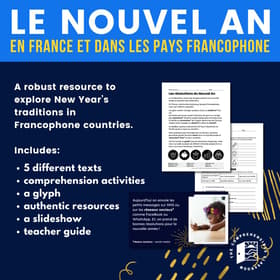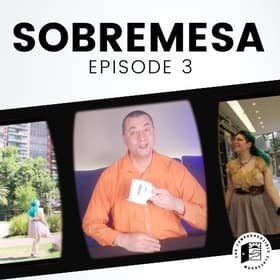

La araña, leyenda quechua | Reading and activities in Spanish
3 versions of the Quechua legend along with activities in Spanish
- Language
- Spanish
- Level
- Multi level, Novice (Levels 1-2), Intermediate (Levels 2-4), Advanced (Levels 4-AP)
- Formats
- Pages
- 10 Pages
La araña is a quechua legend and origin story for spiders. It is about a quechua princess who was spoiled and did not take care of her people and was transformed into a creepy black creature by a goddess.
This resource features three versions of La araña, all written in Spanish: Simplified, Standard, and Complex. Each version of the legend is accompanied by a 1-page comprehension worksheet and a whole-class game or activity. Use each version in a different level of Spanish, or work through all three in sequence to support comprehension for the most complex version. All three versions of the story contain glossaries.
Excerpts from each of the versions are shown in the product preview.
SIMPLIFIED: The Simplified version is a one-page text written with high frequency words in the past tense. It may be understandable to students in Spanish 2, especially if the class uses a communicative, Comprehension-based approach with a strong focus on extensive reading and listening. *Shown in thumbnail
STANDARD: The Standard version is a 2-page text with many details and compound sentence structures. Although it relies heavily on high frequency words and cognates, it uses a broader vocabulary range than the Simplified version. It may be understandable to students in their second or third year of Spanish, depending on whether they have been in courses that have a strong focus on extensive reading and listening. *NOT shown in thumbnail
COMPLEX: The Complex version is a 2-page biography with many details, a broad vocabulary range, and complex sentence structures. It may be understandable to students in their third or fourth year of Spanish, depending on whether they have been in courses that have a strong focus on extensive reading and listening. *Shown in thumbnail
SUGGESTIONS FOR USE:
- The whole class reads the same version
- Differentiate by distributing different versions to different students, and use the whole-class activities for the most simple of the versions distributed
- Students work in pairs to read two versions and identify facts that appear in each
- Read all three versions in sequence, layered in with the whole-class activities provided
- Teach the same lesson in multiple levels, modifying complexity
- Use for sub plans or too-sick-to-teach-days in multiple levels
- Add to class library and let students self-select which text is an appropriate challenge for themselves
- Laminate text on one side and comprehension activities on another and use as part of a Fast Finisher System
LOOKING FOR OTHER CLASS LIBRARY RESOURCES?
- 10 artistas que debes conocer | BUNDLE
- 5 afrolatinas
- 5 fábulas de Esopo
- 5 héroes de la Independencia de México
- 5 personajes de la Revolución Mexicana
- Anansi y el kiwano que habla | Spanish storybook
- Animales peligrosos | BUNDLE
- Cinco animales en peligro de extinción
- Cognates Los animales | Spanish
- Diego Maradona
- El Festival de los Barriletes Gigantes | 3 scaffolded readings
- El que sabe, sabe | Los animales
- El silbo gomero | Spain's Amazing Whistling Language
- Guatemalan Chicken Buses
- Hotel de basura
- La casa azul printable storybook in simple Spanish
- La Isla de Basura
- La revancha de los carpinchos
- Las ranas de cristal | Simple readings in Spanish
- La Tomatina | Simple Reading
- Lionel Messi
- Pop culture personalities | Spanish
- What is an ekeko? | Spanish Reading
-
This is an amazing and comprehensive resource! I have used it for a week and filled my lessons daily using it! It is worth it.
Sra Stevenson -
We used this to learn about the legend and then how the past tense verbs are used. Great way to go over the imp v preterite.
Suzanne K. -
Great activities! I love how each level of the reading has a new activity to complete so everything feels fresh and new!
Srta Burger -
Great time-saving resource. A fun addition to our unit. Thanks for your hard work.
Sandra R. -
My native students really enjoyed learning about this legend. Thank you!
Jion D.




